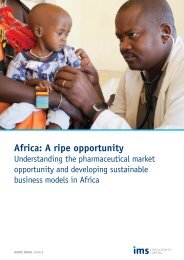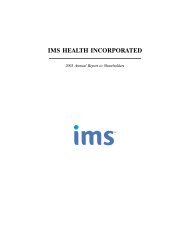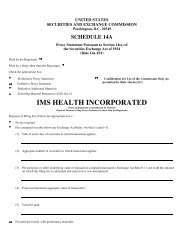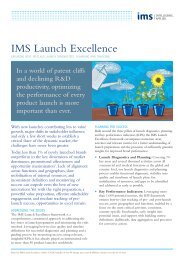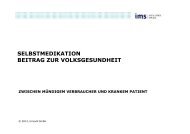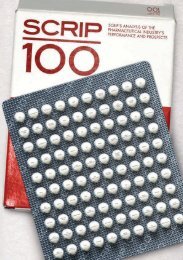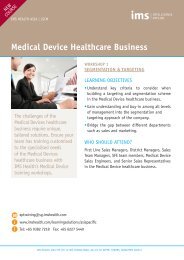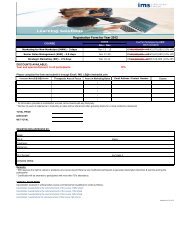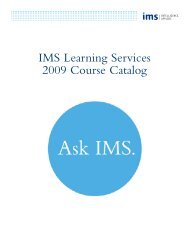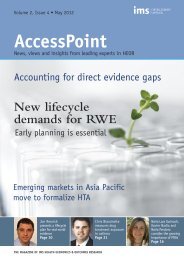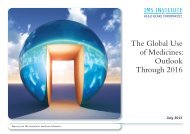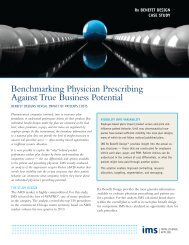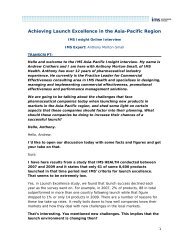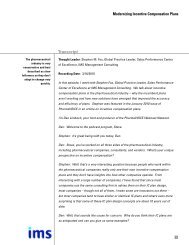Shaping the biosimilars opportunity: A global ... - IMS Health
Shaping the biosimilars opportunity: A global ... - IMS Health
Shaping the biosimilars opportunity: A global ... - IMS Health
Create successful ePaper yourself
Turn your PDF publications into a flip-book with our unique Google optimized e-Paper software.
<strong>Shaping</strong> <strong>the</strong> <strong>biosimilars</strong> <strong>opportunity</strong>:<br />
A <strong>global</strong> perspective on <strong>the</strong> evolving<br />
<strong>biosimilars</strong> landscape
<strong>Shaping</strong> <strong>the</strong> <strong>biosimilars</strong><br />
<strong>opportunity</strong>: A <strong>global</strong><br />
perspective on <strong>the</strong> evolving<br />
<strong>biosimilars</strong> landscape<br />
After several years in <strong>the</strong> slow lane, important changes are driving new<br />
momentum in <strong>the</strong> market for <strong>biosimilars</strong>, paving <strong>the</strong> way for <strong>the</strong>ir accelerated<br />
growth over <strong>the</strong> next decade and beyond. Although currently small and<br />
narrowly focused on a few disease areas and countries, <strong>the</strong> <strong>biosimilars</strong><br />
<strong>opportunity</strong> is set to expand as patents expire on leading biologics, US<br />
legislation comes into effect, and payers push for <strong>the</strong>ir wider adoption to<br />
manage burgeoning costs.<br />
The signs are <strong>the</strong>re, but questions remain. How will <strong>the</strong> commercial prospects<br />
play out? Where is <strong>the</strong> greatest potential? And what will be <strong>the</strong> optimal go-tomarket<br />
model for entrants? Analysis from <strong>IMS</strong> suggests that companies looking<br />
to take advantage of <strong>the</strong> evolving landscape will need carefully planned<br />
strategies, strong commitment and <strong>the</strong> resilience to overcome some<br />
formidable barriers, especially in <strong>the</strong> short-term, to maximize return on<br />
investment.<br />
By 2015, sales of <strong>biosimilars</strong> are expected to<br />
reach between US$1.9-2.6 billion, up from<br />
US$378 million for <strong>the</strong> year to <strong>the</strong> first half of<br />
2011. Potentially, this market could be <strong>the</strong><br />
single fastest-growing biologics sector in <strong>the</strong><br />
next five years – albeit from a small base –<br />
spurred by <strong>the</strong> convergence of major dynamics<br />
that will see new <strong>biosimilars</strong> enter <strong>the</strong> US market<br />
by 2014, bring additional molecules to Europe<br />
through 2015, and open up oncology and<br />
autoimmune disease areas to <strong>biosimilars</strong> for <strong>the</strong><br />
first time ever.<br />
Cost pressures key<br />
The changing outlook for <strong>biosimilars</strong> comes at a<br />
time when <strong>the</strong> <strong>global</strong> pharmaceutical market is<br />
feeling <strong>the</strong> combined impact of two key events: a<br />
period of unprecedented patent expirations on<br />
many of <strong>the</strong> world’s largest pharmaceutical<br />
brands, and a financial crisis that has required<br />
healthcare systems to make significant and<br />
sustained cost reductions.<br />
For payers in <strong>the</strong> advanced markets, limited<br />
economic growth and pressures on healthcare<br />
make <strong>the</strong> patent cliff a true generic dividend,<br />
enabling much needed savings to be realized.<br />
However, as potential savings from generics start<br />
1 • SHAPING THE BIOSIMILARS OPPORTUNITY • December 2011<br />
to decline in <strong>the</strong>se countries over <strong>the</strong> next 5-10<br />
years while <strong>the</strong> imperative to reduce expenditure<br />
continues to grow, payers face an urgent need to<br />
find new ways of rationalizing resources. Biologics<br />
– among <strong>the</strong> most expensive pharmaco<strong>the</strong>rapies<br />
available and now approaching <strong>the</strong>ir own swa<strong>the</strong><br />
of patent expirations – potentially represent <strong>the</strong><br />
most lucrative source of savings on drug<br />
expenditure for Western nations after 2015.<br />
Biosimilars may be <strong>the</strong> key that helps <strong>the</strong>m to<br />
realize this <strong>opportunity</strong>.<br />
Biosimilars also bring clear potential for payers<br />
in <strong>the</strong> emerging pharmaceutical or “pharmerging”<br />
markets, such as Brazil, India and China.<br />
Here, <strong>the</strong> need to broaden healthcare coverage to<br />
large populations increasingly must be balanced<br />
against limited budgets and growing demand for<br />
innovative drugs. Biosimilars offer one way of<br />
widening access and enabling better value to be<br />
obtained from <strong>the</strong> money spent on healthcare. In<br />
some cases (such as South Korea, India and<br />
Brazil) <strong>the</strong>y are seen as a key macroeconomic<br />
driver of growth, attracting foreign capital<br />
by creating manufacturing and R&D centers<br />
of excellence. ➜<br />
<strong>IMS</strong> HEALTH
Whe<strong>the</strong>r <strong>the</strong> US<br />
<strong>opportunity</strong> is<br />
realized is <strong>the</strong> single<br />
most important<br />
differentiator<br />
between success and<br />
failure for <strong>biosimilars</strong><br />
in <strong>the</strong> next decade.<br />
Growing demand for biologics<br />
The imperative to find cost-effective alternatives<br />
to biologics reflects <strong>the</strong> growing demand for <strong>the</strong>se<br />
specialty drugs. Since <strong>the</strong>ir origins in <strong>the</strong> 1980s,<br />
biologics have prospered into a US$138 billion<br />
market (2010), fuelled by such key launches as<br />
recombinant insulins, human growth hormone<br />
(HGH), alteplase, erythropoietins (EPOs),<br />
granulocyte colony stimulating factors (G-CSFs)<br />
and <strong>the</strong>n monoclonal antibodies (MAbs), among<br />
o<strong>the</strong>rs. Currently accounting for 16% of <strong>global</strong><br />
pharmaceutical expenditure and significantly outpacing<br />
total branded sales, biologics will continue<br />
to out-perform <strong>the</strong> <strong>global</strong> market as more<br />
innovative products deliver new treatment options<br />
for a growing range of indications.<br />
Patent expiries driving new potential<br />
A number of top-selling biologic brands,<br />
including Herceptin, Enbrel, Humalog, MabThera,<br />
Remicade and Aranesp, are due to lose product<br />
patent protection over <strong>the</strong> next five years,<br />
opening up a wealth of new possibilities for<br />
<strong>biosimilars</strong> players. Key <strong>the</strong>rapy areas such as<br />
cancer, diabetes and rheumatoid arthritis (RA)<br />
will spearhead this new wave of <strong>biosimilars</strong>, with<br />
attention focused on <strong>the</strong> real prizes of anti-TNF<br />
MAbs, MAbs for oncology, and insulins (Figure 1).<br />
Diverse competitive landscape<br />
A diversified competitive arena for <strong>biosimilars</strong> is<br />
already emerging, with generics manufacturers,<br />
R&D-based pharma, and biotech companies<br />
FIGURE 1: KEY AREAS SUCH AS CANCER, DIABETES AND RA WILL BE AT THE<br />
FOREFRONT OF THE NEW WAVE<br />
Big PharmaCos, not only generics companies, are ready to compete<br />
Core Therapy Areas for biologics (MAT 12/2010)<br />
Insulins<br />
Anti-TNF<br />
Oncology (MAb)<br />
EPO<br />
Multiple sclerosis<br />
CFS-G<br />
Blood coagulation<br />
Ocular antineovasc.<br />
Antiviral (no-HIV)<br />
O<strong>the</strong>r<br />
3.1<br />
2.0<br />
1.5<br />
5.0<br />
7.6<br />
7.3<br />
0 10<br />
Billions $<br />
12.5<br />
15.9<br />
15.8<br />
•Top 5 <strong>the</strong>rapy areas<br />
account for about 70%<br />
of <strong>the</strong> total market<br />
16.5<br />
20<br />
A diversified competitive arena<br />
is emerging<br />
• Teva developing its first<br />
biosimilar version of rituximab<br />
(Mab<strong>the</strong>ra/Rituxan)<br />
• Pfizer recently signed a deal with<br />
Biocon (India) to manufacture<br />
biosimilar insulins<br />
• Merck signed a deal with CRO<br />
Parexel to provide <strong>biosimilars</strong> to<br />
Merck BioVentures (5 late stage<br />
<strong>biosimilars</strong> are expected by 2012)<br />
• Biogen Idec ready to enter <strong>the</strong><br />
<strong>biosimilars</strong> arena as well (“<strong>the</strong><br />
company is in <strong>the</strong> perfect<br />
position...<strong>biosimilars</strong> market as a<br />
low risk” Biogen’s CEO Scangos)<br />
Source: <strong>IMS</strong> <strong>Health</strong><br />
2 • SHAPING THE BIOSIMILARS OPPORTUNITY • December 2011<br />
poised to compete: Teva is approaching <strong>the</strong> end<br />
of Phase II trials for a biosimilar version of<br />
Roche’s rituximab (MabThera/Rituxan); 1 Pfizer<br />
recently signed a deal with Biocon (India) to<br />
manufacture biosimilar insulins; 2 AstraZeneca and<br />
Eli Lilly have both signaled intentions in this<br />
area; 3 Boehringer Ingelheim is creating a<br />
dedicated division for developing and<br />
commercializing its own <strong>biosimilars</strong>; 4 and a<br />
Merck&Co deal with CRO Parexel is expected to<br />
yield five late-stage <strong>biosimilars</strong> by 2012 5 .<br />
Plans to develop <strong>biosimilars</strong> are also being mooted<br />
by leading innovator biotech companies, including<br />
Biogen Idec and Amgen – which has particularly<br />
called-out emerging markets in South America and<br />
Asia. 6 Interest in <strong>the</strong> sector has even extended<br />
beyond <strong>the</strong> realms of pharma: digital technology<br />
leader Fujifilm and electronics giant Samsung have<br />
both now joined <strong>the</strong> race, securing biosimilar<br />
deals with Merck and Quintiles respectively.<br />
Samsung is planning to pursue fur<strong>the</strong>r biotech<br />
ventures in its effort to achieve target revenues of<br />
US$1.8 billion from biopharmaceuticals by 2020 7 .<br />
The entry of <strong>the</strong>se players may not necessarily<br />
herald similar actions from more companies in<br />
o<strong>the</strong>r industries, but it does bring a fresh inflow of<br />
cash to fund development programs and atypical<br />
branding models that have already paid off in<br />
o<strong>the</strong>r industries (Figure 2). The commitment is<br />
clearly <strong>the</strong>re, but how and where will <strong>the</strong> promise<br />
be fulfilled?<br />
Defining <strong>the</strong> market<br />
The <strong>biosimilars</strong> sector has reached very different<br />
stages of evolution around <strong>the</strong> world. Clarity of<br />
guidelines is variable and regulatory pathways<br />
diverse, leading to various definitions of<br />
<strong>biosimilars</strong> (or <strong>the</strong> broader group of follow-on<br />
biologics) across countries and regions. Europe<br />
has by far <strong>the</strong> best-established framework, with<br />
which <strong>the</strong> US is now more or less aligned. ➜<br />
1 http://www.tevapharm.com/en-<br />
US/Products/ProductsPipleine/Pages/default.aspx<br />
2 Pfizer to sell biosimilar insulins in Biocon deal. Accessed 3 Nov, 2011<br />
at http://in.reuters.com/article/2010/10/18/idINIndia-<br />
52267720101018<br />
3 Astra Zeneca eyes move into <strong>biosimilars</strong>. Accessed 11 Nov, 2011 at<br />
http://www.ft.com/cms/s/0/9740a42e-d064-11dd-ae00-<br />
000077b07658.html#axzz1dO1hLirT<br />
4 Boehringer Ingelheim expands its business with <strong>biosimilars</strong>. Accessed 2<br />
Nov, 2011 at http://www.boehringer-ingelheim.co.uk/news/press_release-Boehringer-Ingelheim-expands-its-Business-with-<br />
Biosimilars.html<br />
5 Merck & Co in deal with Parexel to develop <strong>biosimilars</strong>. Accessed 3<br />
Nov, 2011 at<br />
http://www.firstwordplus.com/Fws.do?src=corp_site&articleid=411C<br />
A68F1931475B92F0A475730DE0CA<br />
6 Copying biotech medicine attracts more drugmakers. Accessed 3 Nov,<br />
2011 at http://uk.reuters.com/article/2011/01/13/healthcare-<strong>biosimilars</strong>-idUKN1313681520110113?rpc=401&feedType=RSS&feed-<br />
Name=governmentFilingsNews.<br />
7 High-tech companies buy into biomanufacturing. Accessed 10 Nov,<br />
2011 http://www.genengnews.com/analysis-and-insight/high-techcompanies-buy-into-biomanufacturing/77899375/<br />
<strong>IMS</strong> HEALTH
FIGURE 2: ATYPICAL BRANDING MODELS HAVE PAID OFF IN OTHER INDUSTRIES<br />
Wanted to sell its electronics<br />
in <strong>the</strong> US in <strong>the</strong> ’80s<br />
Best Buy and Home Depot<br />
initially refused assuming low<br />
quality<br />
Entered into <strong>the</strong> US through<br />
second-tier, regional retailers<br />
(e.g. HHGregg, P.C. Richard)<br />
Transformed its brands, from<br />
Lucky Goldstar to Life’s Good<br />
Now LG can be found at all <strong>the</strong><br />
top big-box stores<br />
Biologics Market, LC$ bil<br />
1. US<br />
Potential<br />
leading market<br />
for <strong>biosimilars</strong><br />
20<br />
16<br />
12<br />
8<br />
4<br />
Enter in <strong>the</strong> developed<br />
markets<br />
Disparaged by many western<br />
incumbents as more fattening<br />
(“Mexican Lemonade”)<br />
Long-term focus in educating<br />
consumers and aggressively<br />
branding <strong>the</strong> product as a<br />
lifestyle beer<br />
Downplayed “hecho en Mexico”<br />
effect<br />
World’s 10th best-selling beer<br />
and number 1 imported in <strong>the</strong> US<br />
Source: Adapted from Harvard Business Review, December 2010<br />
2. Advanced economies<br />
Established framework<br />
for <strong>biosimilars</strong>, but<br />
slow uptake<br />
Outside <strong>the</strong>se markets, definitions of agents and<br />
pathways to approval are less precise. It is clear<br />
that follow-on or modified biologics already exist<br />
in China and India as well as in o<strong>the</strong>r countries.<br />
Some of <strong>the</strong>se agents would fit <strong>the</strong> definition of<br />
existing <strong>biosimilars</strong> well; many are essentially<br />
copy versions of patented agents; o<strong>the</strong>rs fail to<br />
meet ei<strong>the</strong>r categorization, yet clearly are not<br />
original. For instance, Reditux, a copy of<br />
rituximab manufactured by Dr Reddy’s, has been<br />
available in India since 2007, but its approval<br />
has been based on a smaller body of evidence<br />
than is likely to be required in Europe or <strong>the</strong> US.<br />
To enable consistent analysis across geographies,<br />
<strong>the</strong>rapies and manufacturers, <strong>IMS</strong> has established<br />
an industry-verified standard market definition<br />
for <strong>the</strong> <strong>biosimilars</strong> sector. This classifies<br />
<strong>biosimilars</strong> (also known as follow on biologics in<br />
FIGURE 3: THREE GEOGRAPHICAL CLUSTERS ARISE, WITH US REPRESENTING A<br />
SIGNIFICANT PORTION OF MARKET POTENTIAL (~60%)<br />
Pharmerging economies anticipated to be a potential growth driver<br />
3. Pharmerging economies<br />
Biosimilars* already established<br />
(looser regulatory pathway) and<br />
fast-growing biologics market<br />
0<br />
Biologics,<br />
US JP SEU CAN CEE TUR BRA MEX CHI KOR IND VTN<br />
2005-10<br />
CAGR<br />
9% 6% 10% 14% 19% 21% 14% 13% 24% 16% 19% 39%<br />
Biologics Market Sales Biosimilars* Uptake, %<br />
Source: <strong>IMS</strong> <strong>Health</strong> MIDAS, 2005-2010<br />
Takeaways for<br />
<strong>biosimilars</strong><br />
incumbents<br />
Focus on likely early<br />
adopters (blockbustertype<br />
<strong>global</strong> launch<br />
strategy not necessarily<br />
<strong>the</strong> most suitable)<br />
Invest on branding and<br />
patient education<br />
3 • SHAPING THE BIOSIMILARS OPPORTUNITY • December 2011<br />
60%<br />
50%<br />
40%<br />
30%<br />
20%<br />
10%<br />
0%<br />
Uptake, %<br />
* Biosimilars in Europe and Japan defined by regulatory<br />
pathway, in pharmerging markets looser approval processes apply<br />
for products that resemble <strong>biosimilars</strong><br />
<strong>the</strong> US and subsequent entry biologics in Canada)<br />
as biologic products approved in a country which<br />
has an abbreviated approval process for biologic<br />
products that references an originator biologic in<br />
<strong>the</strong> regulatory submission. Products marketed in<br />
countries without a biosimilar approval pathway<br />
and for which <strong>the</strong> originator has not granted a<br />
license are not considered true <strong>biosimilars</strong>.<br />
A tale of three geographies<br />
Geographically, <strong>the</strong> market for biologics and<br />
<strong>biosimilars</strong> falls into three distinct clusters: <strong>the</strong><br />
US, <strong>the</strong> o<strong>the</strong>r advanced economies (Europe,<br />
Japan and Canada) and <strong>the</strong> pharmerging markets<br />
(Figure 3). The US accounts for most of <strong>the</strong><br />
<strong>global</strong> spending on biologics and will be a key<br />
driver of long-term <strong>biosimilars</strong> market potential.<br />
The advanced economies have <strong>the</strong> advantage of<br />
an established framework for <strong>biosimilars</strong> but to<br />
date uptake has been slow; Europe is <strong>the</strong> most<br />
progressive. Some of <strong>the</strong> highest growth rates for<br />
biologics are currently seen in <strong>the</strong> pharmerging<br />
markets, where <strong>biosimilars</strong> already exist (albeit<br />
through a looser regulatory pathway) and where<br />
much of <strong>the</strong> immediate growth will be found.<br />
In Japan, <strong>biosimilars</strong> guidelines have been<br />
recently established and follow <strong>the</strong> principles of<br />
<strong>the</strong> EU Framework; biosimilar epoietin alfa has<br />
taken over a quarter of <strong>the</strong> market by volume in a<br />
period of 12 months, but somatropin has done<br />
less well.<br />
US: The big <strong>opportunity</strong><br />
Devoid of a specific regulatory pathway, <strong>the</strong> US<br />
currently has no established industry for<br />
<strong>biosimilars</strong>. At present, <strong>the</strong>re is only one product<br />
on <strong>the</strong> market that could potentially fit this<br />
description – Omnitrope (somatropin/HGH) which<br />
was launched by Sandoz in 2007 under a special<br />
ruling. However, all this is set to change in 2014<br />
when <strong>the</strong> country’s new framework for<br />
<strong>biosimilars</strong>, set out by The Patient Protection and<br />
Affordable Care Act of March 2010, comes into<br />
effect. With leading manufacturers including<br />
Pfizer and Merck already positioned to compete,<br />
and patients and health insurers stepping up <strong>the</strong><br />
pressure for access to low-cost, high-value drugs,<br />
<strong>the</strong> US is forecast to be <strong>the</strong> single biggest<br />
<strong>opportunity</strong> for <strong>biosimilars</strong> by 2020. Whe<strong>the</strong>r this<br />
<strong>opportunity</strong> is realized is <strong>the</strong>refore <strong>the</strong> most<br />
important differentiator between success and<br />
failure for <strong>biosimilars</strong> in <strong>the</strong> next decade.<br />
UNDERSTANDING THE ISSUES<br />
The future market for <strong>biosimilars</strong> in <strong>the</strong> US will<br />
be shaped by a number of factors, not least <strong>the</strong><br />
reaction of managed care and <strong>the</strong> play-out of<br />
pricing dynamics. While many of <strong>the</strong><br />
uncertainties remain to be categorized,<br />
experience from analogous situations offers<br />
important pointers. ➜<br />
<strong>IMS</strong> HEALTH
Among <strong>the</strong> most interesting analogs for<br />
<strong>biosimilars</strong> in <strong>the</strong> US are <strong>the</strong> heavily contracted,<br />
narrow provider populations around<br />
erythropoietins and <strong>the</strong> G-CSFs where <strong>the</strong><br />
influence of managed care is strong and payers<br />
have considerable sway over contracting and <strong>the</strong><br />
defined treatment paradigm for a disease.<br />
This set-up closely parallels, and is likely to<br />
mirror, <strong>the</strong> institutional contracting environment<br />
in Germany (<strong>the</strong> most advanced <strong>biosimilars</strong><br />
market) where a very limited group of doctors<br />
administer erythropoietins in a small number of<br />
centers.<br />
1 Price: For originator companies, one of <strong>the</strong> key<br />
challenges is to anticipate <strong>the</strong> way in which<br />
<strong>biosimilars</strong> will act on price. Heavy price<br />
discounting in <strong>the</strong> institutional sector provides<br />
a strong incentive for <strong>biosimilars</strong> to target a<br />
list price that is very close to <strong>the</strong> originator’s<br />
and subsequently gain <strong>the</strong>ir advantage through<br />
contracts.<br />
2 Established experience: In classes such as<br />
EPOs and G-CSFs, where <strong>the</strong>re is general<br />
acceptance of high similarity between<br />
<strong>biosimilars</strong> and original brands, and established<br />
experience of <strong>the</strong>ir use in Europe, <strong>the</strong> technical<br />
bar is likely to be cleared relatively smoothly.<br />
Likewise, if <strong>the</strong>re is a hospital network or<br />
relatively limited number of clinic/treatment<br />
centers, usage decisions will be faster.<br />
By contrast, <strong>biosimilars</strong> targeting autoimmune<br />
diseases are likely to meet reticence in<br />
switching patients unless and until <strong>the</strong>y fail on<br />
current treatment. Without a significant<br />
financial or co-pay advantage, <strong>the</strong>re is likely to<br />
be little interest from managed care in starting<br />
new patients on <strong>the</strong>se medicines – at least<br />
until <strong>the</strong> safety and substitutability of <strong>the</strong><br />
<strong>biosimilars</strong> are demonstrated.<br />
3 Duration of <strong>the</strong>rapy: The nature of drug use<br />
will be also be a key consideration for <strong>the</strong><br />
adoption of <strong>biosimilars</strong> in <strong>the</strong> US: those intended<br />
for chronic conditions such as RA and psoriasis,<br />
for example, may face particular scrutiny by<br />
payers in considering <strong>the</strong> impact of potential<br />
financial exposure to possibly lifelong <strong>the</strong>rapy.<br />
Conversely, if <strong>the</strong> use of <strong>biosimilars</strong> were to<br />
enable significant savings in <strong>the</strong>se areas, payers<br />
may be more favorably inclined towards <strong>the</strong>m –<br />
provided of course that safety and efficacy are<br />
demonstrated. Much could depend on <strong>the</strong><br />
relative influence of <strong>the</strong> prescribing physicians<br />
and <strong>the</strong> degree to which patients express a<br />
preference for a lower-cost <strong>the</strong>rapy.<br />
4 Familiarity and trust: Doctors are already<br />
familiar with <strong>the</strong> concept and cost benefits of<br />
initiating treatment with generic versions of<br />
non-biologic agents in such conditions as RA,<br />
4 • SHAPING THE BIOSIMILARS OPPORTUNITY • December 2011<br />
but <strong>the</strong>y will need to trust and believe that<br />
<strong>biosimilars</strong> are an effective, safe and cheaper<br />
option to follow suit with biologics. Given that<br />
<strong>the</strong>se biologics remain on <strong>the</strong> Tier 4 formulary<br />
level with 30% patient co-pay, this is likely to<br />
be a slow build.<br />
5 Uncertainties: For US patients and payers, <strong>the</strong><br />
key issues around <strong>biosimilars</strong> are <strong>the</strong><br />
uncertainties. In large patient and provider<br />
populations, <strong>the</strong> level of co-pay will be crucial:<br />
unless <strong>the</strong>y are significantly lower <strong>the</strong>re will be<br />
little incentive for use. The possibility of<br />
moving <strong>biosimilars</strong> to a separate formulary tier<br />
is an option, but one that is likely to be<br />
heavily dependent on a stronger perception of<br />
safety around MAbs. In <strong>the</strong> event that a track<br />
record of success is established in Europe<br />
before market entry in <strong>the</strong> US, and some form<br />
of medical consensus is reached on switching<br />
patients to <strong>biosimilars</strong>, this may change. The<br />
real key for biosimilar manufacturers within<br />
this broader provider community is that it will<br />
take longer to convince individual doctors oneby-one,<br />
versus contracting.<br />
There is also <strong>the</strong> potential in <strong>the</strong> US for greater<br />
biologic volume arising from <strong>the</strong> use of<br />
<strong>biosimilars</strong> – a phenomenon which has already<br />
been observed in Europe (see Figure 6, page 7).<br />
This could put at risk systemic “savings” with<br />
higher utilization, particularly if price<br />
discounting for <strong>biosimilars</strong> is only in <strong>the</strong> region<br />
of 20-30%.<br />
6 Patient role: Increasing co-pays and <strong>the</strong><br />
growing role of patients in treatment decisions<br />
will also be important for <strong>biosimilars</strong>:<br />
manufacturers may choose to differentiate <strong>the</strong>ir<br />
products through <strong>the</strong> use of patient assistance<br />
programs (PAPs) setting <strong>the</strong>ir list price at a<br />
similar level to <strong>the</strong> originator brand and<br />
offering co-pay assistance to <strong>the</strong> patient<br />
through social networking, thus bringing <strong>the</strong>m<br />
into play into <strong>the</strong> decision making process.<br />
SIGNIFICANT POTENTIAL – OVER TIME<br />
Notwithstanding <strong>the</strong> significant potential for<br />
<strong>biosimilars</strong> in <strong>the</strong> US, <strong>the</strong>ir establishment in this<br />
market will be a slow process: stringent clinical<br />
requirements and an involved, potentially drawnout<br />
procedure for resolving patent disputes are<br />
likely to delay <strong>the</strong> speed of uptake in <strong>the</strong> near<br />
future: behind every product patent <strong>the</strong>re are<br />
several potential lines of defense for originator<br />
companies, including process patents, which may<br />
slow <strong>the</strong> entry of biosimilar versions when new<br />
markets open. Given <strong>the</strong> highly technical issues<br />
involved and lack of legal precedent to date,<br />
predictions are difficult to make and questions<br />
remain as to whe<strong>the</strong>r biosimilar versions of <strong>the</strong><br />
more complex biologics (MAbs) will reach <strong>the</strong> US<br />
market before 2015. ➜<br />
<strong>IMS</strong> HEALTH
It will also take time for <strong>the</strong> FDA and payers to<br />
build a learning curve on <strong>biosimilars</strong> and for<br />
physicians to overcome <strong>the</strong>ir concerns over safety<br />
and preferentially adopt <strong>the</strong>se products: <strong>the</strong>y will<br />
have to believe in <strong>the</strong> ability to technically,<br />
safely and consistently reproduce <strong>the</strong>se<br />
molecules. The financial motivation for both<br />
payers and patients will also be crucial. However,<br />
even if technology regulatory barriers do hinder<br />
<strong>biosimilars</strong> take-off in <strong>the</strong> US until 2015, <strong>the</strong><br />
financial incentives - for both public and private<br />
stakeholders - will ultimately drive uptake longterm,<br />
with <strong>the</strong> entry of leading US companies<br />
fostering credibility of <strong>the</strong> sector.<br />
Europe: The first market<br />
The EU presents <strong>the</strong> most advanced market for<br />
<strong>biosimilars</strong>, accounting for 80% of <strong>global</strong><br />
spending on <strong>the</strong>se molecules. However, despite a<br />
strong legislative foundation, to date only a few<br />
manufacturers have launched <strong>biosimilars</strong> in <strong>the</strong><br />
region. These include a mixture of existing<br />
generics houses, <strong>the</strong> generics arms of major<br />
companies and new ventures, most notably<br />
Sandoz/Novartis, Stada, Hospira, Medice and<br />
Ratiopharma (Teva). Biosimilars are established<br />
in three <strong>the</strong>rapy areas in Europe: EPOs for<br />
treating anemia caused by renal dialysis, G-CSFs<br />
for lowered white blood cell counts after<br />
chemo<strong>the</strong>rapy, and HGH.<br />
VARIED PENETRATION<br />
The penetration of <strong>biosimilars</strong> varies by country,<br />
reflecting local pricing and reimbursement<br />
policies, stakeholder influence, and attitudes<br />
towards <strong>the</strong>ir adoption and use. Currently,<br />
Germany and France account for half <strong>the</strong><br />
FIGURE 4: OVERALL WE CAN IDENTIFY TWO UPTAKE PATTERNS FOR<br />
BIOSIMILARS, DIFFERENTIATED VS. COMMODITY<br />
Differentiated markets will pose several challenges to <strong>biosimilars</strong><br />
Uptake SU, %<br />
100%<br />
80%<br />
60%<br />
40%<br />
20%<br />
0%<br />
T0<br />
T3<br />
T6<br />
T9<br />
T12<br />
T15<br />
T18<br />
T21<br />
T24<br />
T27<br />
T30<br />
T33<br />
T36<br />
T39<br />
T42<br />
T45<br />
Source: <strong>IMS</strong> <strong>Health</strong><br />
Filgrastim uptake, SU MAT 6/2011<br />
Commodity market<br />
Germany<br />
UK France<br />
Spain Italy<br />
Uptake SU, %<br />
100%<br />
80%<br />
60%<br />
40%<br />
20%<br />
0%<br />
Somatropin uptake, SU MAT 6/2011<br />
Differentiated market<br />
T0<br />
T3<br />
T6<br />
T9<br />
T12<br />
T15<br />
T18<br />
T21<br />
T24<br />
T27<br />
T30<br />
T33<br />
T36<br />
T39<br />
T42<br />
T45<br />
T48<br />
T51<br />
T54<br />
T57<br />
T60<br />
Germany<br />
UK France<br />
Spain Italy<br />
5 • SHAPING THE BIOSIMILARS OPPORTUNITY • December 2011<br />
<strong>biosimilars</strong> market by value in <strong>the</strong> region with a<br />
34% and 17% share respectively across Europe,<br />
although uptake in Spain and <strong>the</strong> UK has started<br />
to increase.<br />
Across markets, G-CSFs have generally achieved<br />
<strong>the</strong> highest penetration by value and HGH <strong>the</strong><br />
lowest (25% and 4% class uptake respectively).<br />
The lower penetration of HGH has been largely<br />
driven by <strong>the</strong> greater element of patient choice<br />
and discrimination over devices and convenience.<br />
Original brand Genotropin, for example, is<br />
available in a form which does not require<br />
refrigeration, whereas this is a prerequisite for <strong>the</strong><br />
biosimilar version. Cautious prescribing has also<br />
played a role, with physicians hesitant to use<br />
biosimilar HGH given <strong>the</strong> time it takes to show an<br />
effect: with G-CSFs, <strong>the</strong> impact of treatment is<br />
more readily apparent, enabling physicians to<br />
change course in a faster timeframe if required. In<br />
<strong>the</strong> case of EPOs, uptake is more driven by payer<br />
than patient concerns, given <strong>the</strong> lack of any<br />
discernible difference in <strong>the</strong> patient experience as<br />
a result of switching to a biosimilar.<br />
Uptake also varies across countries when <strong>the</strong>rapy<br />
areas are considered according to type (Figure 4),<br />
being significantly lower in differentiated markets<br />
where <strong>the</strong> stakeholder landscape is extremely<br />
complex, <strong>the</strong> value proposition is high and <strong>the</strong><br />
market is driven by price (eg, somatropin) versus<br />
commodity markets where access is mostly<br />
controlled by payers and <strong>the</strong> product has limited<br />
intrinsic value (eg, G-CSF and <strong>the</strong> epoietins).<br />
LIMITED SUCCESS<br />
VERSUS SMALL MOLECULE GENERICS<br />
To date, <strong>the</strong> first wave of <strong>biosimilars</strong> has met<br />
with limited success if compared to <strong>the</strong> uptake of<br />
small molecule generics. This can be partly<br />
explained by limited price reductions: average<br />
list (ex-manufacturer) price cuts in <strong>the</strong> region of<br />
30% are considerably below those for generics<br />
which are typically around 70%-80%. However,<br />
<strong>the</strong> pattern is one of inconsistent uptake: while<br />
some countries in Europe with powerful payers<br />
and robust generics markets, such as Germany,<br />
have seen strong penetration, o<strong>the</strong>rs such as <strong>the</strong><br />
UK, which are also highly focused on generics<br />
and have strong payers, have seen low<br />
penetrations. O<strong>the</strong>r countries with apparently<br />
high sales of <strong>biosimilars</strong> such as Greece are, in<br />
fact, most likely simply source countries for <strong>the</strong><br />
burgeoning German market. ➜<br />
<strong>IMS</strong> HEALTH
FUTURE EVOLUTION<br />
The learning curve for <strong>biosimilars</strong> is essentially<br />
still building in Europe and <strong>the</strong> high clinical<br />
requirements of <strong>the</strong> new MAbs and anti-TNFs will<br />
present fur<strong>the</strong>r hurdles ahead. In <strong>the</strong> meantime,<br />
small molecule generics continue to represent <strong>the</strong><br />
main source of cost savings in <strong>the</strong> region.<br />
However, <strong>the</strong> clarity of EU regulation and <strong>the</strong><br />
need for fur<strong>the</strong>r cost-containment action in <strong>the</strong><br />
unfavorable economic climate are likely to ease<br />
<strong>the</strong> uptake of <strong>biosimilars</strong> going forward, as<br />
payers become more familiar with <strong>the</strong>ir use,<br />
tendering processes are established and lateadopting<br />
markets such as Italy and Spain follow<br />
<strong>the</strong> leading countries.<br />
Pharmerging economies: On a fast track<br />
Most of <strong>the</strong> pharmerging markets, including China,<br />
India, Brazil and Mexico, have developed <strong>the</strong>ir own<br />
regulatory pathway to manage <strong>the</strong> approval of<br />
<strong>biosimilars</strong>. While often drawing on <strong>the</strong> European<br />
framework, <strong>the</strong>se generally set a lower barrier in<br />
terms of clinical trial requirements and regulatory<br />
control. This enables local manufacturers to enter<br />
<strong>the</strong> pharmerging markets on a more level playing<br />
field, but it also potentially provides a lower cost<br />
entry point for international players. Such a looser<br />
structure has already fuelled <strong>the</strong> launch of<br />
modified biologics within <strong>the</strong> oncology and EPO<br />
markets in key countries such as China.<br />
Going forward, government initiatives are<br />
anticipated to boost <strong>the</strong> <strong>biosimilars</strong> market in<br />
FIGURE 5: US WILL REPRESENT THE CORNERSTONE OF THE BIOSIMILARS<br />
MARKET IN THE LONG RUN, WITH AN UPSIDE POTENTIAL OF UP TO<br />
25 BIL US$ IN 2020<br />
Biosimilars not a short-term game<br />
Biosimilar Market Size, LC$ Bil<br />
30<br />
25<br />
20<br />
15<br />
10<br />
5<br />
0<br />
2011 2012 2013 2014 2015 2016 2017 2018 2019 2020<br />
Source: <strong>IMS</strong> <strong>Health</strong><br />
2015<br />
1,9 - 2,6 Bil US$<br />
• Slow uptake in <strong>the</strong> US due to new<br />
legislation enabling innovators to<br />
delay <strong>the</strong> approval process of<br />
new <strong>biosimilars</strong><br />
• Uptake in Europe acelerates due to<br />
more mature framework<br />
• Emerging countries (Asia specifically)<br />
ramping up<br />
Lower Bound<br />
Biosimilars market evolution, 2010 - 2020<br />
2020<br />
11 - 25 Bil US$<br />
• Key upside drivers represented<br />
by <strong>the</strong> US market<br />
Base Case Upper Bound<br />
6 • SHAPING THE BIOSIMILARS OPPORTUNITY • December 2011<br />
25<br />
20<br />
11<br />
Share of biologics<br />
market - 2020<br />
10%<br />
8%<br />
4%<br />
south-east Asian countries, principally as a means<br />
of sustaining <strong>the</strong>ir domestic industry. Within <strong>the</strong><br />
concentrations of biopharmaceutical<br />
manufacturing <strong>global</strong>ly, bio-clusters are already<br />
emerging in this region, some of <strong>the</strong>m matching<br />
<strong>the</strong> quality standards of advanced economies.<br />
South Korea in particular, with plans to become a<br />
leading <strong>biosimilars</strong> player, is actively expanding<br />
its world-class clinical trials and production<br />
infrastructure, cultivating bio-specialized<br />
manpower, reinforcing <strong>global</strong> export capability,<br />
building R&D, legal and system support strategies.<br />
Although <strong>the</strong> biologics market is still at an early<br />
stage in <strong>the</strong> pharmerging economies it is<br />
expanding fast and <strong>biosimilars</strong> will play a key<br />
role in its future growth. However, <strong>the</strong> unique<br />
nature of <strong>the</strong>se countries may see a market that<br />
evolves over time in an entirely different fashion.<br />
Whe<strong>the</strong>r European and US manufacturers of<br />
<strong>biosimilars</strong> will be able to enter more easily or<br />
find <strong>the</strong>mselves locked out by local competition<br />
is currently an open question.<br />
2020 outlook<br />
Within <strong>the</strong> three main geographic clusters, a<br />
number of differentiating factors will impact <strong>the</strong><br />
value generation <strong>opportunity</strong> for <strong>biosimilars</strong>,<br />
including ease of access in <strong>the</strong> short term, speed<br />
of uptake, clarity of regulation and, particularly,<br />
<strong>the</strong> role of public and private stakeholders.<br />
Accordingly, most of <strong>the</strong> immediate value will be<br />
sourced from <strong>the</strong> pharmerging markets, spurred<br />
by <strong>the</strong> anticipated flow of new patients. However,<br />
in <strong>the</strong> long-run, <strong>the</strong> US will be <strong>the</strong> cornerstone of<br />
<strong>the</strong> <strong>global</strong> <strong>biosimilars</strong> market, powering a sector<br />
worth between US$11 billion and US$ 25 billion<br />
in 2020 (Figure 5) representing a 4% and 10%<br />
share respectively of <strong>the</strong> total biologics market.<br />
The overall penetration of <strong>biosimilars</strong> within <strong>the</strong><br />
off-patent biological market is forecast to reach<br />
up to 50% by 2020, assuming a price discount in<br />
<strong>the</strong> range of 20-30% (or 40-50% with tender<br />
discounts included).<br />
Underlying this forecast are six core drivers with<br />
<strong>the</strong> potential to spur or curb future growth of <strong>the</strong><br />
<strong>biosimilars</strong> market: <strong>the</strong> US uptake, <strong>the</strong> spread of<br />
<strong>biosimilars</strong> in pharmerging markets, <strong>the</strong><br />
continued pattern of evolution in Europe,<br />
technology and <strong>the</strong> second wave of <strong>biosimilars</strong>,<br />
volume effect and <strong>the</strong> competitive landscape. ➜<br />
<strong>IMS</strong> HEALTH
FIGURE 6: AS SHOWN BY G-CSF, THE INTRODUCTION OF BIOSIMILARS CAN<br />
GENERATE A SPILL-OVER EFFECT ON OFF-PATENT BIOLOGIC MOLECULES<br />
Opportunity for <strong>biosimilars</strong> players only or also for innovators?<br />
% of SU vs. t-1 (year prior to <strong>the</strong><br />
introduction of <strong>biosimilars</strong>)*<br />
Volume effect after <strong>the</strong> introduction of <strong>biosimilars</strong><br />
G-CSF, SU<br />
Volume effect<br />
130%<br />
120%<br />
110%<br />
100%<br />
90%<br />
80%<br />
t-4 t-3 t-2 t-1 t0 t+1 t+2<br />
Years before <strong>biosimilars</strong> introduction<br />
France Germany Italy Spain Sweden UK<br />
Source: <strong>IMS</strong> MIDAS, MAT Q4 2010, NHS. *t-1 =100%, t0 = year of <strong>biosimilars</strong> introduction<br />
Source: <strong>IMS</strong> <strong>Health</strong><br />
UK case study<br />
Physicians moved<br />
G-CSF back in 1st<br />
line cancer<br />
treatment due to<br />
lower <strong>biosimilars</strong><br />
cost<br />
G-CSF prevents<br />
hospital<br />
readmission due<br />
to infections<br />
Similar evidence<br />
is collected in<br />
o<strong>the</strong>r countries<br />
(e.g. Sweden)<br />
1 US uptake: The core upside driver of<br />
<strong>biosimilars</strong> value in 2020 is uptake in <strong>the</strong> US<br />
long-term (2014-15), unlocking market<br />
potential and economies of scale. Any<br />
limitations on this, for example due to<br />
regulations favoring innovator companies, will<br />
drive down <strong>the</strong> likelihood of significant growth.<br />
2 Pharmerging markets: Growth is also dependent<br />
on <strong>the</strong> pharmerging countries becoming a key<br />
<strong>biosimilars</strong> player in terms of both manufacturing<br />
and market size. The more moderate spread of<br />
<strong>biosimilars</strong> in developing markets and any<br />
shortfall in quality standards that prevents <strong>the</strong>se<br />
countries from materializing as leading exporters<br />
could impact overall potential.<br />
3 Europe: Late-adopting major EU markets such<br />
as Spain and Italy will need to follow Germany<br />
in terms of <strong>biosimilars</strong> uptake to maximize<br />
prospects for growth; it is possible that<br />
physician and payer resistance may impede<br />
this, negatively impacting <strong>the</strong> 2020 outlook.<br />
4 Technology: If <strong>the</strong> US is <strong>the</strong> key driver of<br />
upside potential, <strong>the</strong> higher complexity of<br />
future biosimilar targets may be <strong>the</strong> barrier<br />
that hinders future growth. Technical hurdles,<br />
particularly devices in <strong>the</strong> case of anti-TNFs,<br />
will be a challenge for manufacturers and one<br />
that may not be overcome by several<br />
companies at once. These issues could prevent<br />
<strong>biosimilars</strong> tapping into all <strong>the</strong>rapy areas where<br />
biologics are off-patent, curtailing <strong>the</strong> number<br />
of successful launches across <strong>the</strong>rapy areas.<br />
5 Volume effect: There is potential for a<br />
significant volume effect on biologics<br />
consumption, as observed with G-CSF in <strong>the</strong> UK<br />
7 • SHAPING THE BIOSIMILARS OPPORTUNITY • December 2011<br />
and Sweden (see Case in Practice: G-CSF -<br />
Figure 6). This could drive up <strong>biosimilars</strong><br />
market growth considerably or equally<br />
constrain it should uptake be insufficient to<br />
generate a spill-over incentive.<br />
6 Competitive landscape: The forecast assumes<br />
that major markets will drive positive financial<br />
returns and <strong>biosimilars</strong> growth, enabling a<br />
good degree of competition. Should financial<br />
barriers and poor uptake in major markets yield<br />
a limited number of competitors, growth<br />
prospects will be similarly reduced.<br />
Against this background, how will <strong>the</strong><br />
competitive landscape for <strong>biosimilars</strong> evolve<br />
going forward?<br />
Stakeholder moves<br />
To date, one of <strong>the</strong> main challenges for<br />
<strong>biosimilars</strong> has been <strong>the</strong> reluctance of payers,<br />
prescribers and patients to accept <strong>the</strong>se products<br />
in place of <strong>the</strong> original brands. Going forward, <strong>the</strong><br />
reaction of <strong>the</strong>se stakeholders and <strong>the</strong> chosen<br />
strategies of aspiring players, and particularly<br />
innovators, will be key to <strong>the</strong>ir speed of uptake:<br />
• Payers: As yet, <strong>biosimilars</strong> have not been a key<br />
priority for payers and <strong>the</strong>re has been little, if<br />
any, top-down pressure urging a move to<br />
extensive biosimilar prescribing. Limited price<br />
discounts, sophisticated products and lack of<br />
familiarity with <strong>the</strong>ir use has perhaps made <strong>the</strong><br />
decision less clear cut than for small molecule<br />
generics. Going forward, however, this is likely<br />
to change as <strong>biosimilars</strong> move into <strong>the</strong> higher<br />
cost areas of oncology and autoimmune diseases<br />
and efforts to rationalize healthcare intensify.<br />
Emphasis will be placed on <strong>the</strong> strongest<br />
assurances of clinical safety and efficacy.<br />
• Patients: Increasingly vocal in <strong>the</strong>ir treatment<br />
decisions, patients are also becoming more<br />
focused on broader and affordable access to<br />
treatment. However, it is likely that <strong>the</strong>y will<br />
be heavily influenced by physician guidance on<br />
administration of <strong>biosimilars</strong> and <strong>the</strong>y may not<br />
even be aware whe<strong>the</strong>r <strong>the</strong>y are being treated<br />
with a biosimilar or an originator product.<br />
• Physicians: Lack of experience with <strong>biosimilars</strong><br />
and <strong>the</strong> newness of <strong>the</strong> regulatory pathway<br />
have led to a natural conservatism in<br />
prescribing approach among many physicians.<br />
The learning curve has yet to be built and<br />
overcoming safety and efficacy concerns will be<br />
paramount to <strong>the</strong>ir acceptance of <strong>biosimilars</strong>.<br />
Usage will vary by <strong>the</strong>rapy area but it is likely<br />
to be contained to small groups of new patients<br />
initially, with close monitoring of outcomes<br />
before considering more widespread use. ➜<br />
<strong>IMS</strong> HEALTH
• Aspiring players: With significant capital<br />
invested in <strong>biosimilars</strong>, <strong>the</strong> entry of branded<br />
players bringing R&D capabilities, and<br />
<strong>biosimilars</strong> addressing multiple areas of <strong>the</strong><br />
strategic agenda, would-be entrants are clearly<br />
key to <strong>the</strong> sector’s success going forward.<br />
• Originators: The lifecycle management<br />
strategies of <strong>the</strong> originator companies have an<br />
important role to play in driving volume<br />
expansion, with <strong>the</strong> power to limit uptake<br />
opportunities in advanced economies whilst<br />
growing penetration in pharmerging markets.<br />
To date, many originators have chosen to<br />
develop biobetters or functionally enhanced<br />
biologics, such as pegylated, long-acting<br />
formulations, and have sought to establish<br />
<strong>the</strong>se newer versions as <strong>the</strong> standard of care.<br />
This has met with some success in certain<br />
areas – most notably with Amgen’s launch of<br />
Aranesp and Neulasta, second generation<br />
versions of Epogen and Neupogen respectively.<br />
More sustainably, originators have established<br />
extremely strong relationships with prescribers,<br />
KOLs and patients, based on services, clinical<br />
development and investment, which <strong>biosimilars</strong><br />
may struggle to replicate. Patent disputes,<br />
especially in <strong>the</strong> US, where <strong>the</strong> legislation<br />
requires disclosure of patent information by<br />
<strong>the</strong> biosimilar manufacturer, may also delay or<br />
prevent <strong>the</strong> entry of some <strong>biosimilars</strong>.<br />
FIGURE 7: ALTHOUGH RISKY, THE EXPECTED PRODUCTIVITY OF INVESTING IN<br />
BIOSIMILARS MATCHES OR OUTPACES BENCHMARK RETURNS FROM R&D<br />
Biosimilars IRR<br />
(Number of competitors<br />
in <strong>the</strong> market)<br />
Internal Rate of Return (IRR) Biosimilar vs. industry benchmark<br />
Industry benchmark<br />
(R&D IRR of 12 Top<br />
R&D PharmaCos)<br />
11.5% Median IRR<br />
Most likely interval<br />
for <strong>biosimilars</strong> IRR<br />
6.4% - 15%<br />
-10 -5 0 5 10 15 20 25 30<br />
10-year IRR<br />
Critical factors<br />
• Time-to-market<br />
(First mover vs. Follower)<br />
• Value chain optimization,<br />
especially on R&D and<br />
manufacturing<br />
• Degrees of competition<br />
(Numbers of competitors<br />
into <strong>the</strong> market)<br />
Source: <strong>IMS</strong> analysis. Benchmark from Deloitte & Thomson Reuters Research 2010 (publicly available document)<br />
8 • SHAPING THE BIOSIMILARS OPPORTUNITY • December 2011<br />
Challenging arena<br />
For new entrants, <strong>biosimilars</strong> pose very different<br />
challenges to those presented by small molecule<br />
generics, with more demanding requirements in<br />
terms of clinical development, market access,<br />
manufacturing and sales and marketing<br />
capabilities:<br />
• High development costs: Developing a<br />
biosimilar is not a simple process but one that<br />
requires significant investment, technical<br />
capability and clinical trial expertise. Average<br />
cost estimates range from US$100-250 million<br />
(various industry sources) if plant development<br />
is included (or US$20-100 million for non-plant<br />
cost). Whilst lower than <strong>the</strong> costs of<br />
developing a small molecule NCE, <strong>the</strong>y are<br />
never<strong>the</strong>less orders of magnitude higher than<br />
<strong>the</strong> costs associated with developing<br />
traditional generics, which are typically around<br />
US$1-4 million.<br />
• Fledgling regulatory framework: In most<br />
markets apart from Europe, <strong>the</strong> regulatory<br />
framework for <strong>biosimilars</strong> is generally still very<br />
new compared to <strong>the</strong> well-established approval<br />
process for NCEs and small-molecule generics;<br />
in some cases it is non-existent, making <strong>global</strong><br />
investments risky.<br />
• Manufacturing issues: Barriers to developing a<br />
<strong>biosimilars</strong> manufacturing capability are not<br />
prohibitive, but <strong>the</strong> development of <strong>biosimilars</strong><br />
involves sophisticated technologies and<br />
processes, raising <strong>the</strong> risk of <strong>the</strong> investment.<br />
In <strong>the</strong> near term, entrants face limited benefits<br />
of scale, relative to incumbents, and in specific<br />
areas such as insulins, strict requirements for<br />
compatibility with existing devices will apply.<br />
• Branded mentality: Winning <strong>the</strong> trust of<br />
stakeholders will call for many of <strong>the</strong> skills,<br />
resources and branded mentality of a<br />
conventional innovative pharmaceutical<br />
company – potentially involving changes to<br />
commercial models. Initiatives to allay safety<br />
concerns among physicians and patients will be<br />
particularly important, supported by sales<br />
teams with deeper medical and technical<br />
knowledge. This will mean significant<br />
investment in sales and marketing – initially at<br />
least – using ei<strong>the</strong>r internal commercial<br />
capabilities or by sourcing <strong>the</strong>se from branded<br />
companies. Investment in pricing and market<br />
access will also be increasingly important: postmarketing<br />
surveillance is already mandatory in<br />
Europe and <strong>the</strong> US is likely to follow. ➜<br />
<strong>IMS</strong> HEALTH
The higher break-even requirements and<br />
technology barriers associated with <strong>biosimilars</strong><br />
are likely to make <strong>the</strong> competitive arena less<br />
crowded than generics. However, <strong>the</strong> ability to<br />
build <strong>the</strong> right commercial capabilities will be key<br />
to ensuring a successful go-to-market strategy.<br />
Compelling returns, wide appeal<br />
Despite <strong>the</strong> inherent risk, <strong>the</strong> expected<br />
productivity of investing in <strong>biosimilars</strong> could<br />
match or exceed benchmark returns from R&D. In<br />
fact, simulating <strong>the</strong> potential internal rate of<br />
return (IRR) 8 of a biosimilar investment<br />
compared to an industry benchmark shows that it<br />
could actually yield a higher IRR than developing<br />
a brand new biologic (Figure 7).<br />
FIGURE 8: SOLVING THE TRADE-OFF BETWEEN IN-HOUSE AND STRATEGIC<br />
ALLIANCES WILL BE KEY FOR FUTURE SUCCESS IN BIOSIMILARS<br />
Focusing along <strong>the</strong> whole value chain will be a must to generate value<br />
Clinical<br />
development and<br />
regulatory<br />
Leverage of internal<br />
assets or outsource of<br />
capabilities from outer<br />
suppliers to speed up<br />
development and<br />
ensure compliance<br />
with regulatory<br />
requirements<br />
CLINICAL SUCCESS<br />
AND SPEED TO<br />
MARKET<br />
Source: <strong>IMS</strong> <strong>Health</strong><br />
FIGURE 9: BIOSIMILARS CAN BE VIEWED FROM TWO DIFFERENT ANGLES<br />
– VALUE PROTECTION VS. VALUE GENERATION<br />
Originators lifecycle strategy can potentially address both perspectives<br />
Risk evaluation<br />
Risk mitigation<br />
strategy<br />
Post-LOE resource<br />
allocation<br />
Source: <strong>IMS</strong> <strong>Health</strong><br />
VALUE<br />
PROTECTION<br />
What is <strong>the</strong> business at<br />
risk and how is it spread<br />
across regions?<br />
Who are <strong>the</strong> key<br />
stakeholders?<br />
What actions should we<br />
undertake to minimize<br />
risk? (IP, pricing,<br />
volume effect, lifecycle<br />
strategy)<br />
How can we optimize<br />
deployment of resources<br />
post-LOE?<br />
Biosimilars value chain<br />
Market<br />
access<br />
Optimize time to<br />
market and ensure<br />
key stakeholders<br />
(KOLs, payers) are<br />
onboard and<br />
supportive to drive<br />
advocacy and<br />
acceptance<br />
BUILD TRUST AND<br />
NETWORK<br />
DEVELOPMENT<br />
Biosimilars<br />
Manufacturing<br />
costs<br />
Scale up production<br />
(through in-house<br />
investments or<br />
alliances) to achieve<br />
economies of scale,<br />
although in <strong>the</strong><br />
short-term is quite<br />
unlikely to happen<br />
OPTIMIZE SUPPLY<br />
CHAIN AND<br />
MANUFACTURING<br />
VALUE<br />
GENERATION<br />
How and where do<br />
<strong>biosimilars</strong> fit within<br />
our strategic agenda?<br />
What are <strong>the</strong> building<br />
blocks for implementing<br />
a successful biosimilar<br />
strategy?<br />
What is <strong>the</strong> optimal goto-market<br />
model across<br />
geographies and based<br />
on target <strong>the</strong>rapy areas?<br />
Sales and<br />
marketing<br />
Tailor go-to-market<br />
approach to local<br />
dynamics, both in<br />
terms of sales force<br />
model and marketing<br />
offering (e.g. device,<br />
patient management<br />
services)<br />
BRANDED<br />
MENTALITY TO<br />
DRIVE ADOPTION<br />
Strategic fit<br />
Entry strategy<br />
Go-to-market<br />
design<br />
9 • SHAPING THE BIOSIMILARS OPPORTUNITY • December 2011<br />
Fur<strong>the</strong>rmore, <strong>biosimilars</strong> can fit within <strong>the</strong><br />
strategic agenda of various company profiles – as<br />
demonstrated by <strong>the</strong> eclectic mix of innovator<br />
manufacturers, generics houses and players from<br />
o<strong>the</strong>r industries that are already entering <strong>the</strong><br />
sector. They offer a source of long-term financial<br />
returns, an <strong>opportunity</strong> to address diminishing<br />
pipeline productivity and a basis for building an<br />
R&D platform for <strong>the</strong> future. Importantly, too,<br />
<strong>the</strong>y provide access to <strong>the</strong> fast-growing<br />
pharmerging markets where critical new patient<br />
segments are easier to penetrate. The enormous<br />
potential of <strong>the</strong> pharmerging markets is a key<br />
upside driver and for many companies a principal<br />
reason for investing in <strong>biosimilars</strong> despite <strong>the</strong><br />
high financial barriers short-term.<br />
A fur<strong>the</strong>r key attraction of <strong>biosimilars</strong> for R&Dbased<br />
companies is <strong>the</strong> <strong>opportunity</strong> to develop<br />
biobetters or biosuperiors – ie, improvements to<br />
originator biological molecules as opposed to<br />
structural imitations of <strong>the</strong> originator. For<br />
manufacturers, a major advantage of biobetters is<br />
<strong>the</strong>ir lower early-stage R&D costs compared to<br />
originator drugs.<br />
In reality, regulatory pathways in <strong>the</strong> EU and US<br />
could encourage <strong>the</strong> development of biobetters<br />
ra<strong>the</strong>r than <strong>biosimilars</strong>. These biobetters would<br />
use <strong>the</strong> standard biological approval route, ra<strong>the</strong>r<br />
than <strong>the</strong> abbreviated pathway used by <strong>biosimilars</strong>.<br />
This would mean that biobetters, as ‘new drugs’,<br />
would benefit from market exclusivity.<br />
Tapping <strong>the</strong> potential<br />
Unlocking <strong>the</strong> potential of <strong>biosimilars</strong> will require<br />
a focused strategy along <strong>the</strong> whole value chain,<br />
from optimizing <strong>the</strong> clinical development program<br />
through developing <strong>the</strong> most suitable strategy for<br />
commercialization. Balancing <strong>the</strong> trade-off<br />
between in-house versus strategic alliances will<br />
be essential for achieving cost efficiencies and<br />
speeding up time to market, with fur<strong>the</strong>r tailoring<br />
by geography to cope with a heterogeneous<br />
landscape (Figure 8). Entry into pharmerging<br />
markets, for example, will be strongly governed by<br />
partnerships with local players.<br />
The <strong>opportunity</strong> afforded by <strong>biosimilars</strong> can be<br />
considered from two different standpoints: ei<strong>the</strong>r<br />
as a means of protecting current value or as a<br />
source of new value generation. For companies<br />
focused on value protection, evaluating and<br />
mitigating risk will be key with a view to<br />
optimizing resource allocation post-LOE; those<br />
looking to join <strong>the</strong> <strong>biosimilars</strong> journey will need<br />
to thoroughly assess <strong>the</strong>ir strategic fit, <strong>the</strong><br />
building blocks for successful entry and <strong>the</strong><br />
optimal go-to-market model design (Figure 9). ➜<br />
8 IRR is used in capital budgeting to measure and compare <strong>the</strong> profitability<br />
of investment options (also known as discounted cash flow rate of return)<br />
<strong>IMS</strong> HEALTH
Summary<br />
To date, limited experience with <strong>biosimilars</strong><br />
captures only a small portion of <strong>the</strong>ir anticipated<br />
future potential, as powerful economic pressures<br />
increase <strong>the</strong>ir appeal to payers in mature and<br />
pharmerging markets. Never<strong>the</strong>less, <strong>the</strong>re are<br />
major barriers in place which mean that it may<br />
be challenging to be successful. The <strong>biosimilars</strong><br />
sector is also at very different stages in each of<br />
<strong>the</strong> major regions and will likely take a different<br />
course. Ultimately, from <strong>the</strong> heterogeneous<br />
group of <strong>biosimilars</strong> entrants and would-be<br />
players, <strong>the</strong> number of winners may be small.<br />
FOR FURTHER INFORMATION, SEE OVERLEAF...<br />
10 • SHAPING THE BIOSIMILARS OPPORTUNITY • December 2011<br />
Companies looking to take advantage of <strong>the</strong><br />
<strong>biosimilars</strong> <strong>opportunity</strong> will need to be clear of<br />
<strong>the</strong>ir strategic relevance within <strong>the</strong> organization,<br />
in terms of portfolio fit, financial suitability and<br />
synergies within <strong>the</strong> value chain, bearing in mind<br />
that this may be an established or pharmerging<br />
markets play. A full understanding of <strong>the</strong><br />
financial upsides and risks of <strong>the</strong> investment will<br />
be critical, based on realistic scenarios of <strong>the</strong><br />
size of <strong>the</strong> potential, <strong>the</strong> <strong>the</strong>rapy areas where it<br />
will be found, and whe<strong>the</strong>r collaboration and<br />
alliances are required to access <strong>the</strong> necessary<br />
skills. An effective market access strategy will<br />
be vital for successful entry: <strong>the</strong> value<br />
proposition is complex and will need to address<br />
<strong>the</strong> full range of stakeholders – including payers,<br />
physicians and patients whose opinion will be<br />
critical. Robust, up-to-date intelligence will also<br />
be key: competitors will be diverse and <strong>the</strong>ir<br />
quantity unknown. Above all, companies will<br />
need commitment: <strong>the</strong> prospects are good and<br />
growing but <strong>biosimilars</strong> will likely be a<br />
long-term game.•<br />
<strong>IMS</strong> HEALTH
Working with <strong>IMS</strong> in <strong>biosimilars</strong><br />
We work closely with clients and leading industry groups to keep pace with market changes.<br />
Our highly relevant, consistent metrics cover <strong>the</strong> trends driving <strong>global</strong> change and innovation<br />
— from new distribution channels and emerging markets to generics, biologics and<br />
<strong>biosimilars</strong> — and help clients successfully adapt to new realities. Our key approach to<br />
supporting organizations in addressing <strong>the</strong> key issues to successfully exploit <strong>the</strong> <strong>biosimilars</strong><br />
<strong>opportunity</strong> is highlighted below.<br />
FIT WITHIN<br />
STRATEGIC AGENDA<br />
• How do <strong>biosimilars</strong> fit<br />
within a company<br />
strategic agenda?<br />
- Portfolio synergies<br />
- Financial suitability<br />
- Synergies within <strong>the</strong><br />
value chain (R&D,<br />
manufacturing, sales<br />
& marketing)<br />
• What are <strong>the</strong> financial<br />
upsides and risks of<br />
investing in <strong>biosimilars</strong>?<br />
• In which <strong>the</strong>rapy areas to<br />
pursue this strategy?<br />
• How to develop a<br />
successful biosimilar entry<br />
strategy?<br />
FOR FURTHER INFORMATION<br />
Please contact Sarah Rickwood at srickwood@uk.imshealth.com<br />
or Antonio Iervolino at aiervolino@imscg.com<br />
<strong>IMS</strong> <strong>Health</strong><br />
7 Harewood Avenue, London NW1 6JB<br />
NEW GEOGRAPHIC<br />
OPPORTUNITIES<br />
• The US is <strong>the</strong> biggest<br />
biologics market: how to<br />
enter it successfully when<br />
<strong>the</strong> biosimilar <strong>opportunity</strong><br />
opens up?<br />
• What o<strong>the</strong>r countries<br />
offer new opportunities for<br />
biosimilar markets, and<br />
how to enter?<br />
• How to maximize uptake<br />
in <strong>the</strong> EU landscape?<br />
• What are <strong>the</strong> likely<br />
competitive scenarios<br />
(originators/o<strong>the</strong>r<br />
biosimilar competitors)?<br />
• What are key drivers and<br />
barriers to manage<br />
stakeholders across<br />
geographies and how to<br />
deal with <strong>the</strong>m (e.g.<br />
Branded approach, DTC)?<br />
©2011 <strong>IMS</strong> <strong>Health</strong> Incorporated or its affiliates. All Rights Reserved.<br />
NEW THERAPEUTIC<br />
OPPORTUNITIES<br />
• Which biosimilar<br />
<strong>the</strong>rapeutic markets will<br />
be <strong>the</strong> most attractive?<br />
• What are <strong>the</strong> likely<br />
barriers to entry?<br />
- Investment levels<br />
(e.g. Marketing<br />
capabilities, device)?<br />
- Stakeholder<br />
management?<br />
- Market access<br />
approach? (e.g.<br />
Pricing, development<br />
of <strong>the</strong> appropriate<br />
clinical package)<br />
- Launch preparation?<br />
GO OR NO-GO? WHAT IS THE OPTIMAL APPROACH?<br />
INVESTMENT AND<br />
INFRASTRUCTURE FOR<br />
SUCCESS<br />
• What is <strong>the</strong> optimal<br />
go-to -market model for<br />
a successful <strong>biosimilars</strong><br />
business?<br />
- Integration and<br />
synergies with existing<br />
business<br />
- Partnership and strategic<br />
alliances<br />
• What skillsets and<br />
resource levels will be<br />
needed, internationally<br />
and locally, to address<br />
new geographic and<br />
<strong>the</strong>rapeutic markets?<br />
• What Key Performance<br />
Indicators should be used<br />
to manage and measure<br />
<strong>the</strong> business?



